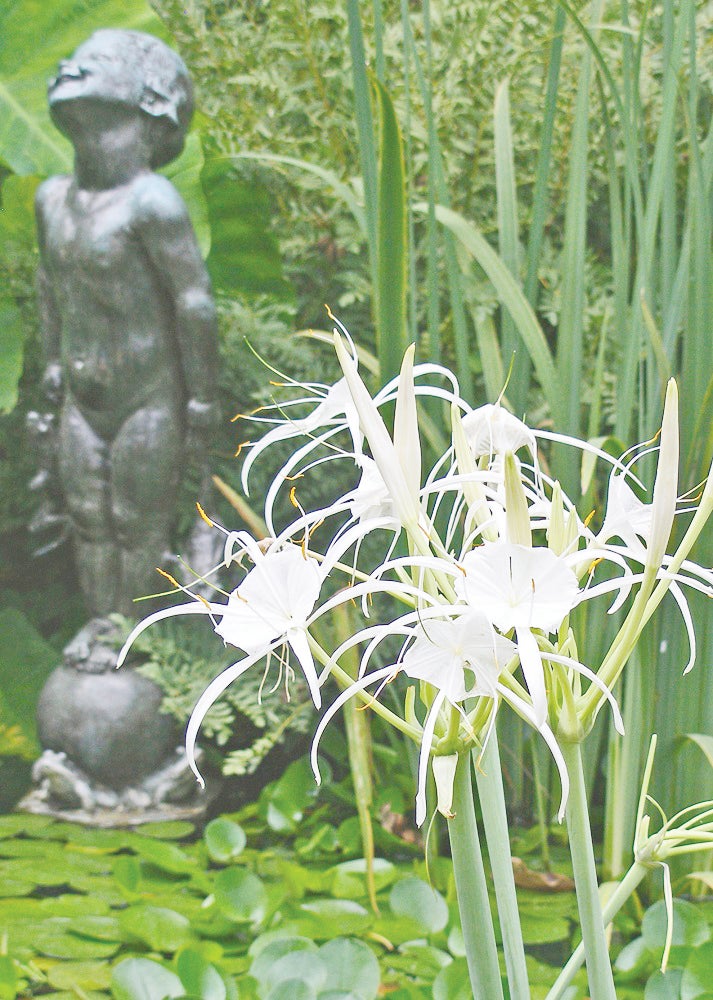Boggy areas have good plant potential
Published 10:00 am Thursday, March 23, 2023

- Swamp spiderlily (Hymenocallis) and other varieties can be seen in both Mississippi ditches and major botanic gardens and home gardens alike, growing in otherwise miserable low wet spots. (Rushing)
By Felder Rushing
Choosing and growing plants in normal conditions is challenging enough to hobby gardeners and home landscapers. But when the growing conditions themselves are nigh impossible, it can be daunting even to bag o’tricks horticulturists.
Not talking about normal hard-to-grow spots like found indoors, small patios, or dense shade and matted tree roots. We can work around those. The two most taxing to me are “hell strips” and boggy areas.
Trending
The first one is what we find between sidewalks and street curbs, and in parking lots, where plants usually have to cope with intense sun, radiated heat, frigid winter winds, no water other than rainfall or splashes from passing vehicles, and restrictions on how tall or wide they can grow without impeding traffic views or strolling people.
I’ve found a few, a very short list, including super dwarf nandinas, dwarf yaupon hollies, short daffodils, compact “white flags” iris, Mexican primrose, and a few more. But it’s still painful to watch.
The other is more common, especially in the Delta where I was raised: Gardens that are low and prone to temporary flooding, staying saturated for days or weeks but then drying out the rest of the summer.
This is deadly to roots of most landscape plants, which may tolerate short periods of wet or dry but on average require both air and water at the same time to grow and function, or they can drown and rot.
Those that survive usually have very shallow roots near the surface, which, come dry weather, are unable to reach down deep to find water and nutrients to keep plants going.
Enter what I call ditch plants. These are the trees, shrubs, and flowering perennials you see growing in wetland edges of lakes, ponds, rivers, and swamps, and sometimes in very shallow water; botanists call them “emergent zone” plants. Many can also grow perfectly well in regular good garden soil, but tolerate heavy clay, and – importantly – the double whammy of areas that stay too wet, then too dry, for weeks on end.
Trending
A lot of designers faced with boggy areas of a landscape haul in dirt to fix the situation. But savvy ones, including several in the Jackson area, actually go with the flow, lightly digging and shaping the edges to create deliberate, very shallow temporary pools that dry out most of the year.
These “rain gardens” often have an overflow lined with rocks that function as a dry creek most of the year and are surrounded with some astoundingly beautiful native wetland plants, just like we can see in ditches alongside highways.
Some of the most popular landscape-quality wetland plants include bald cypress, red maple, sweet bay magnolia, and wax myrtle; shrubs that tolerate periodic flooding include dwarf palmetto, sweetspire, yaupon holly, and buttonbush.
Some of my fav wetland perennials for gardens include Louisiana iris, narrow leaf sunflower, stokes aster, red cardinal flower, river oats grass, goldenrod, obedient plant (Physostegia), Texas star hibiscus, blue star (Amsonia), Liatris, and swamp spiderlily (Hymenocallis). There are others, but I see all these in both Mississippi ditches and major botanic gardens and home gardens alike, growing in otherwise miserable low wet spots.
My friend Bob Brzuzek, MSU landscape architecture professor and former director of the Crosby Arboretum, wrote a thorough publication with how-to and lists of the best plants for wet Mississippi gardens. Go to MSUCARES.com and in the search box type rain gardens.
So, in line with my difficult situation mantra of “if you can’t fix it, flee it, or fight it, flow with it” we no longer have to be daunted by boggy garden spots.
Felder Rushing is a Mississippi author, columnist, and host of the “Gestalt Gardener” on MPB Think Radio. Email gardening questions to rushingfelder@yahoo.com.





